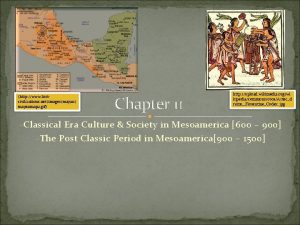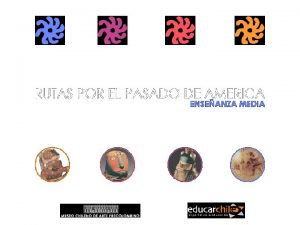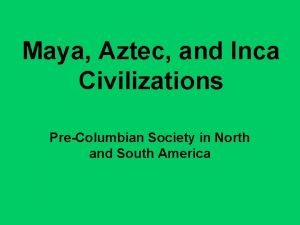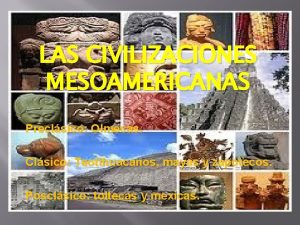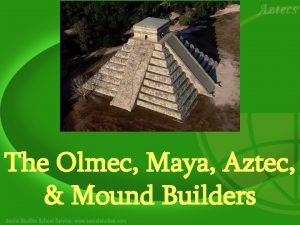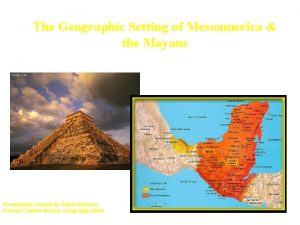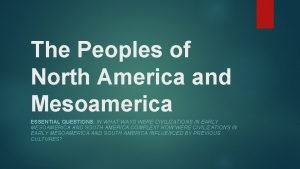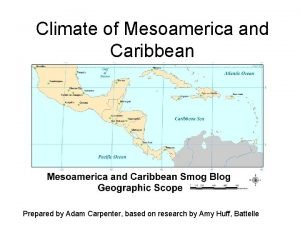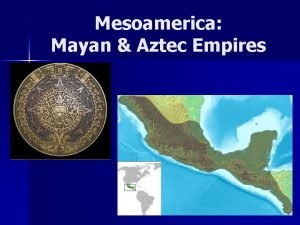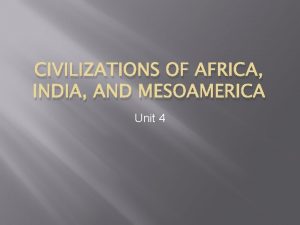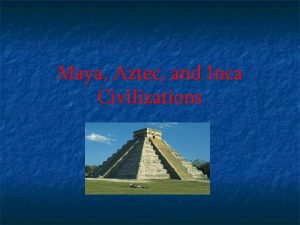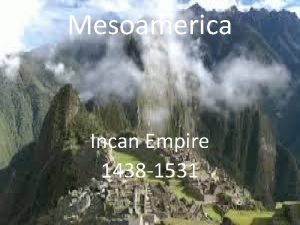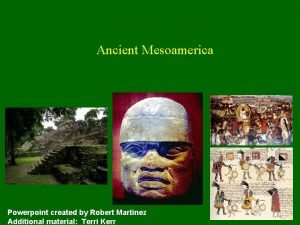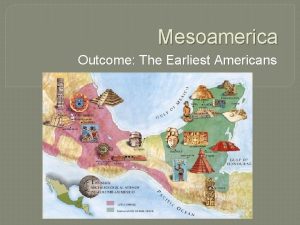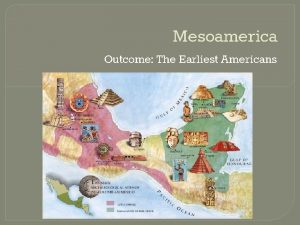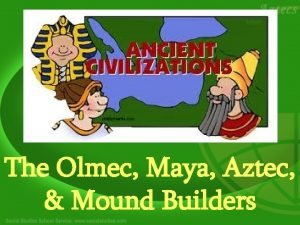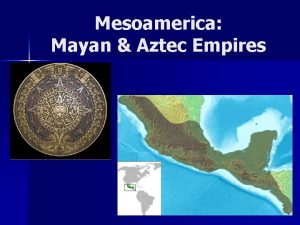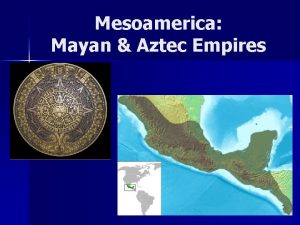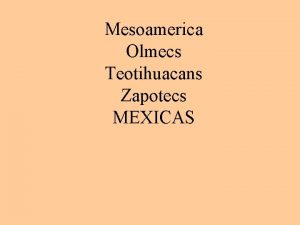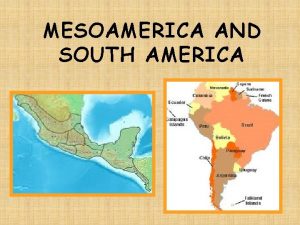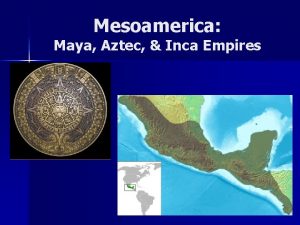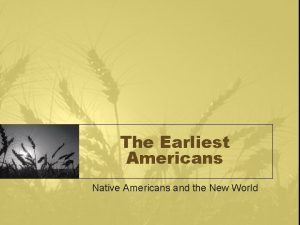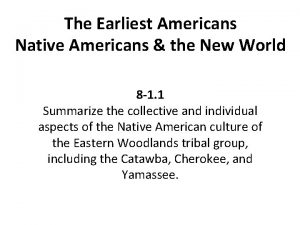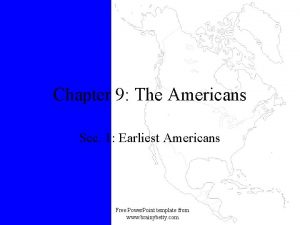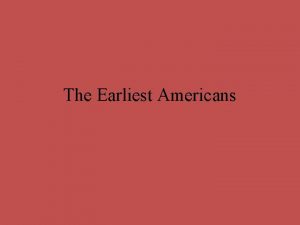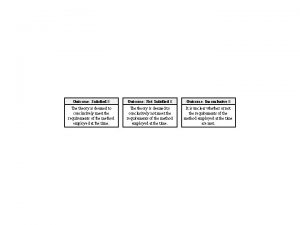Mesoamerica Outcome The Earliest Americans The Earliest Americans
















- Slides: 16

Mesoamerica Outcome: The Earliest Americans

The Earliest Americans 1. North and South America a. b. c. d. Stretches unbroken 9, 000 miles Originally connected to Asia by a land bridge called Beringia Most inhabitants (or ancestors) migrated this way Others traveled by boat

Beringia

The Earliest Americans 2. Peopling of America a. b. c. Started arriving after the Ice Age (1. 9 million – 10, 000 B. C. ) Ice Age lowered sea levels (hence Beringia) and allowed wild herds from Siberia to migrate to the Americas People followed the herds and became first Americans (hunters and gatherers)

The Earliest Americans 2. Peopling of America (continued…) d. Some say earliest humans found in North or South America date back to 40, 000 B. C. or 10, 000 B. C. e. Evidence? Spearheads found in New Mexico date back to 9, 500 B. C. f. 12, 000 -10, 000 years ago the Ice Age ended- Ice melted and Beringia was swallowed g. Agriculture began about 7, 000 B. C. With agriculture came permanent settlements h.

What is Mesoamerica?

The Olmec People

The Earliest Americans 3. Mesoamerica a. Olmec i. iii. iv. v. Located in the jungles of S. Mexico around 1200 B. C. Often called Mesoamerica’s “mother culture” Large head discovered in 1860 (p. 244) Built columns, altars, & colossal sculpted heads Olmec thrived from 800 -400 B. C. vi. Believed to have worshipped variety of nature gods including the jaguar spirit vii. Collapse: Unknown. Possibilities include decline by outside rulers or possibly that the Olmec began destruction of their monuments when their leaders died

Olmec Head

The Zapotec

The Earliest Americans b. Zapotec i. Developed around time of declining Olmec in Oaxaca Valley ii. Oaxaca Valley has fertile soil, mild climate, and enough rainfall to support agriculture iii. By 500 B. C. they had created early forms of writing and a calendar system

The Earliest Americans iv. First real urban center in Mesoamerica: Monte Alban, which at its peak had 25, 000 people 1. Paved stones 2. Towering Pyramids, temples, palaces v. Decline of Zapotec is also a mystery

Monte Alban

The Earliest Americans c. Olmec and Zapotec Legacy i. ii. Influence powerful Maya Olmec left notions of planned ceremonial centers & some glyph writing iii. Zapotec leave hieroglyphics & calendar system iv. Zapotec are America’s first city builders

The Earliest Americans 4. Other a. b. Moche, Nazca, and Chavin build centers in South America Nazca lines (p. 248)

The Earliest Americans � Result: The Earliest Americans left a lasting legacy on North and South America that would eventually influence two of Mesoamerica’s greatest cultures: The Mayas and the Aztecs.
 Mesoamerican society
Mesoamerican society Mesoamerica culturas
Mesoamerica culturas Mesoamerica inca
Mesoamerica inca Periodo clásico los teotihuacanos, mayas y zapotecos
Periodo clásico los teotihuacanos, mayas y zapotecos Mesoamerica vocabulary
Mesoamerica vocabulary Chinampas del viso
Chinampas del viso Geography of mesoamerica
Geography of mesoamerica Arte precolombino pinturas
Arte precolombino pinturas Mesoamerica inca
Mesoamerica inca The peoples of north america and mesoamerica
The peoples of north america and mesoamerica Climate in mesoamerica
Climate in mesoamerica Climate of mesoamerica
Climate of mesoamerica Quipus
Quipus What part of mexico were the aztecs from
What part of mexico were the aztecs from Lesson 1 the peoples of north america and mesoamerica
Lesson 1 the peoples of north america and mesoamerica Terrace farming mesoamerica
Terrace farming mesoamerica Mesoamerica powerpoint
Mesoamerica powerpoint
